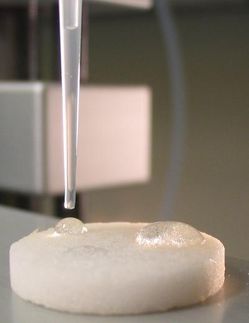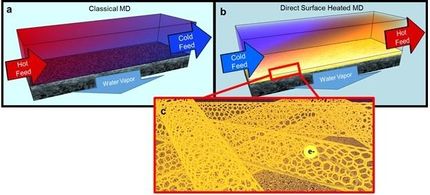Researchers develop better membranes for water treatment, drug delivery
Researchers at the University of Illinois have developed a new generation of biomimetic membranes for water treatment and drug delivery. The highly permeable and selective membranes are based on the incorporation of the functional water channel protein Aquaporin Z into a novel A-B-A triblock copolymer.
The experimental membranes, currently in the form of vesicles, show significantly higher water transport than existing reverse-osmosis membranes used in water purification and desalination. The researchers describe their membranes in a paper accepted for publication in the Proceedings of the National Academy of Sciences.
"We took a close look at how kidneys so efficiently transport water through a membrane with aquaporins, and then we found a way to duplicate that in a synthetic system," said Manish Kumar, a graduate research assistant at the U. of I., and the paper's lead author.
Unlike most biological membranes, polymer membranes are very stable and can withstand considerable pressure - essential requirements for water purification and desalination processes. "Placing aquaporins in materials that we can use outside the body opens doors to industrial and municipal applications," Kumar said.
To make their protein-polymer membranes, the researchers begin with a polymer that self-assembles into hollow spheres called vesicles. While the polymer is assembling, the researchers add Aquaporin Z - a protein found in Escherichia coli bacteria.
"Aquaporin Z makes a hole in the membrane that only water can go through, so it's both fast and selective," said membrane specialist Mark Clark, a professor of civil and environmental engineering and one of the paper's co-authors.
"By varying the amount of Aquaporin Z, we can vary the membrane's permeability," Kumar said, "which could be very useful for drug-delivery applications."
With their high permeability and high selectivity, the biomimetic membranes also are ideal for water treatment by desalination, which is becoming increasingly important for water purification in semiarid coastal regions.
When tested, the productivity of the Aquaporin Z-incorporated polymer membranes was more than 10 times greater than other salt-rejecting polymeric membranes.
Currently, the experimental polymer membranes exist only as small vesicles. "Our next step is to convert the vesicles into larger, more practical membranes," Kumar said. "We also want to optimize the membranes for maximum permeability."
Most read news
Topics
Organizations
Other news from the department science

Get the chemical industry in your inbox
By submitting this form you agree that LUMITOS AG will send you the newsletter(s) selected above by email. Your data will not be passed on to third parties. Your data will be stored and processed in accordance with our data protection regulations. LUMITOS may contact you by email for the purpose of advertising or market and opinion surveys. You can revoke your consent at any time without giving reasons to LUMITOS AG, Ernst-Augustin-Str. 2, 12489 Berlin, Germany or by e-mail at revoke@lumitos.com with effect for the future. In addition, each email contains a link to unsubscribe from the corresponding newsletter.




























































